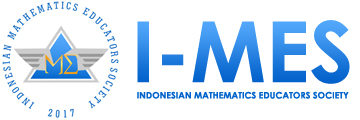Mathematical Knowledge on Changu Narayan Temples’ Arts and Architectures: Ethnomathematics Perspective
Abstract
Keywords
Full Text:
PDFReferences
Abdullah, A. S. (2017). Ethnomathematics in perspective of sundanese culture. Journal on Mathematics Education, 8(1), 1-16.
Apriandi, D., & Ayuningtyas, A. D. (2022). Mathematics Teaching Materials Based on the Ethnomathematics of Shiva Temple by Applying the "Tri-N" Teaching. AL-ISHLAH: Jurnal Pendidikan. 14(2), 1597-1606.
Arisetyawan, A., Suryadi, D., Herman, T., Rahmat, C., & No, J. D. S. (2014). Study of Ethnomathematics: A lesson from the Baduy Culture. International Journal of Education and Research, 2(10), 681-688.
Barton, B., Poisard, C., & Domite, M. D. C. (2006). Cultural connections and mathematical manipulations. For the Learning of Mathematics, 26(2), 21-24.
Bonapace, C., & Sestini, V. (2003). Traditional materials and construction technologies used in the Kathmandu valley (p. 180). Paris: United Nations Educational, Scientific and Cultural Organization.
Bonotto, C. (2007). How to replace word problems with activities of realistic mathematical modelling. In Modelling and applications in mathematics education: The 14th ICMI Study (pp. 185-192). Boston, MA: Springer US.
D’Ambrosio, U. (1989). A Research Program and a Course in the History of Mathematics: Ethnomathematics. Historia Mathematica, 16(3), 285–287.
d’Entremont., Y. (2015). Linking mathematics, culture, and community. Procedia - Social and Behavioral Sciences, 174 (2015).
D'Ambrosio, U. (1990). The role of mathematics education in building a democratic and just society. For the Learning of Mathematics, 10(3), 20-23.
Ernest, P. (1996). Popularization: myths, massmedia and modernism. In International Handbook of Mathematics Education: Part 1 (pp. 785-817). Dordrecht: Springer Netherlands.
ERO. (2019). Report of National Assessment of Student Achievement (NASA) 2018 (Grade 5: Mathematics and Nepali). Sanothimi: Education Review Office. Sanothimi
Fitrianawati, M., Sintawati, M., Marsigit, M., & Retnowati, E. (2020). Developing ethnomatematics in geometry learning for elementary schools students: A preliminary design. International Journal of Scientific and Technology Research, 9(1), 2754-2758.
Gueudet, G., & Trouche, L. (2009). Towards new documentation systems for mathematics teachers?. Educational studies in mathematics, 71, 199-218.
Hartshorne, R. (2013). Geometry: Euclid and beyond. Springer Science & Business Media.
Johnson, J. D., Smail, L., Corey, D., & Jarrah, A. M. (2022). Using Bayesian networks to provide educational implications: Mobile learning and ethnomathematics to improve sustainability in mathematics education. Sustainability, 14(10), 5897.
Lévi, S., 1905, Le Népal: Étude historique d’un royaume hindou, Paris.
Luitel, B. C. (2009). Culture, worldview, and transformative philosophy of mathematics education in Nepal: A cultural-philosophical inquiry. (Doctoral dissertation, Curtin University).
Mania, S., & Alam, S. (2021). Teachers’ perception toward the use of ethnomathematics approach in teaching math. International Journal of Education in Mathematics, Science and Technology, 9(2), 282-298.
Marsigit, dkk (2014). Pengembangan Perangkat Pembelajaran Etnomatematika untuk Meningkatkan Kompetensi Mahasiswa Pendidikan Matematika‖ Jurdikmat FMIPA.UNY
Muhtadi, D., & Prahmana, R. C. I. (2017). Sundanese Ethnomathematics: Mathematical Activities in Estimating, Measuring, and Making Patterns. Journal on Mathematics Education, 8(2), 185-198.
Narulita, D., Mardiyana, M., & Saputro, D. R. S. (2019). Ethnomathematics in Traditional Wayang Performance in Surakarta as a Source of Mathematics Learning in Junior High School. Budapest Int. Res. Critics Linguist. Educ. J, 2(2), 115-122.
Okyere, M. (2022). Culturally Responsive Teaching Through the Adinkra Symbols of Ghana and its Impact on Students' Mathematics Proficiency.
Orey, D. C., & Rosa, M. (2010). Ethnomodeling: a pedagogical action for uncovering ethnomathematical practices.
Orey, D. C., & Rosa, M. (2020). Positionality and creating dialogue in Nepal: connecting ethnomathematics and modelling-the importance of place through ethnomodelling.
Orey, D. C., & Rosa, M. (2021). Ethnomodelling as a glocalization process of mathematical practices through cultural dynamism. The Mathematics Enthusiast, 18(3), 439-468.
Pathuddin, H., & Nawawi, M. I. (2021). Buginese Ethnomathematics: Barongko Cake Explorations as Mathematics Learning Resources. Journal on Mathematics Education, 12(2), 295-312.
Pradhan, J. B. (2017). Mathematical ideas in Chundara culture: Unfolding a Nepalese teaching and learning system. Ethnomathematics and its diverse approaches for mathematics education, 125-152.
Pradhan, J. B. (2018). Mathematical ideas in cultural artefacts: A metaphor for teaching of school mathematics. International Journal of Scientific and Research Publications, 8(9), 335-341.
Prahmana, R. C. I., & D'Ambrosio, U. (2020). Learning Geometry and Values from Patterns: Ethnomathematics on the Batik Patterns of Yogyakarta, Indonesia. Journal on Mathematics Education, 11(3), 439-456.
Prahmana, R.C.I., Yunianto, W., Rosa, M., & Orey, D.C. (2021). Ethnomathematics: Pranatamangsa System and the Birth-Death Ceremonial in Yogyakarta. Journal on Mathematics Education, 12(1), 93-112.
Reeves, S., Peller, J., Goldman, J., & Kitto, S. (2013). Ethnography in qualitative educational research: AMEE Guide No. 80. Medical teacher, 35(8), e1365-e1379.
Rosa, M., & Orey, D. (2011). Ethnomathematics: the cultural aspects of mathematics. Revista Latinoamericana de Etnomatemática: Perspectivas Socioculturales de La Educación Matemática, 4(2), 32-54.
Rosa, M., & Orey, D. (2011). Ethnomathematics: the cultural aspects of mathematics. Revista Latinoamericana de Etnomatemática: Perspectivas Socioculturales de La Educación Matemática, 4(2), 32-54.
Sharma, T., & Orey, D. C. (2017). Meaningful mathematics through the use of cultural artifacts. Ethnomathematics and its Diverse Approaches for Mathematics Education, 153-179.
Shilpakar, R., Maskey, P. N., & Silpakar, P. (2021). Construction technology of multi-tiered temples and their rehabilitation after 2015 April Earthquake in Bhaktapur. Progress in Disaster Science, 10, 100177.
Sulasteri, S., Nur, F., & Kusumayanti, A. (2020). Ethnomathematics: The exploration of learning geometry at Fort Rotterdam of Makassar. In Proceedings of the International Conference on Mathematics and Islam (ICMIs 2018) (pp. 151-157).
Turan, S., & Matteson, S. M. (2021). Middle school mathematics classrooms practice based on 5E instructional model. International Journal of Education in Mathematics, Science and Technology, 9(1), 22-39.
Wagley, M. P., Sharma, T. N., Koirala, B. N., Ramos, S. Y., Taylor, P. C., Luitel, B. C., ... & Bhandari, U. (2008). Developing culturally contextualised mathematics resource materials: capturing local practices of Tamang and Gopali communities.
Refbacks
- There are currently no refbacks.

This work is licensed under a Creative Commons Attribution-NonCommercial-ShareAlike 4.0 International License.
Indonesian Journal of Ethnomathematics
Indonesian Mathematics Educators Society
Jl. Terusan Jend. Sudirman, Kec. Cimahi Tengah, Kota Cimahi, Jawa Barat 40521
E-mail: [email protected]
ISSN: 2775-8001


